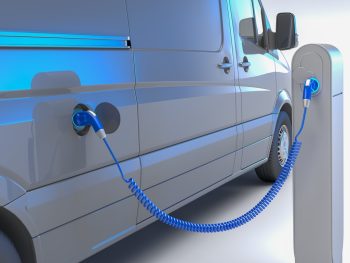Electric vehicles continue to contend with reputation-damaging myths. From theories that the batteries don’t last through to fears that you simply can’t charge them anywhere, misconceptions abound. But, according to Ashley Barnett, head of fleet consultancy, and Andy Hill, strategic LCV fleet engineering consultant at Lex Autolease, one of the biggest is that electric LCVs simply aren’t fit for purpose.
Here, they break down the myths surrounding electric LCVs and explore their capabilities, demonstrating that it is possible for businesses of all sizes to reduce their fleet emissions.

Commercial vehicles exist to serve a vital purpose – to help a business ‘do the day job’ and ultimately generate a profit.
It follows that fleet managers would naturally opt for vehicles that they are certain can carry out day-to-day operations efficiently over ones that they have concerns about, while ensuring budgets aren’t overspent. Confidence is key.
Our customers make these decisions every day. Often they will be worried that the range of electric LCVs won’t be far enough for their deliveries, that the infrastructure simply isn’t there, or that the batteries don’t last, are too heavy or take up space that’s needed for carrying payload.
But electric vans are suitable for deliveries and daily operations.
We’re already seeing many large corporations across the UK roll them out successfully. For example, facilities management and services company Mitie already operates a 66% electric fleet, one of the largest pure electric fleets in the UK, and we know from experience that it’s possible for smaller companies too.
From single vehicle operators such as painter/decorators and florists to those with national networks, there is room for electric vehicles in every fleet.
Why now?
Government mandates for manufacturers to sell a certain percentage of electric vehicles continue to drive adoption. And having already entered 2025’s order and delivery cycles, any orders that are placed from now will be in next year’s registrations. With that in mind, some manufacturers might decide to limit bulk orders for commercial vehicles to those that are at least 16% electric to ensure that they meet their quota for the year.
Can they go the distance?
But despite pressure from manufacturers, some businesses worry that the range of electric LCVs won’t be enough for their deliveries, so their drivers are likely to run out of electricity. However, only 0.001% of traditional fuel drivers run out of fuel, and that number is almost the same for EV drivers according to data from Tusker and AA.
Is the infrastructure there?
Concerns also remain that there’s a lack of charging points in the UK, but our public charging network has rapidly expanded and is in a much better place than many drivers believe. In fact, there are over 70,000 EV charging devices in the UK – a 32% increase since the end of 2023, which means there are now more electric public charging points than there are petrol pumps.
And that number is growing all the time. In October 2024 alone, 1,025 net new EV public charging devices were added to the Zapmap database. It’s forecast that the UK will have over 100,000 by summer next year.
Are the batteries built to last?

As well as showcasing developments in infrastructure, we’re always working to dispel myths around electric vehicles’ battery health, particularly as negative experiences with phone batteries, such as shutdown or rapid drain, have shaped how some people feel about EVs.
Used electric vehicles are built to last – so much so that most manufacturers offer a battery warranty that’s around 100,000 miles or eight years for 75% retained capacity for their vehicles – which wouldn’t happen if they weren’t confident.
Improvements in battery technology have also resulted in quicker recharge times, allowing for smaller batteries and increased payload capacity.
Looking at costs holistically
Even if a business is convinced of the capabilities of electric LCVs, transitioning to an electric fleet means investing budget and time. For many businesses, that means considering the risk versus reward is crucial before taking the leap.
There’s no getting away from it – electric LCVs are more expensive upfront than ICE vehicles. However, if you do your maths and use data to look at whole-life costs – the total cost of ownership figures over the course of a lease – then you could end up seeing savings. Maintenance costs are typically lower, for example, and there are potential tax benefits dependant on how you finance them.
Reflecting on funding
It might also be time for fleet managers to rethink their funding method. The market for electric LCVs is still relatively young, so the risk against reward can be seen as high for some.
If you’re worried about the market value risk, then contract hire will likely be your go-to solution.
If a customer historically has purchased their commercial vehicles and isn’t worried about market value risk then it might be worth exploring different funding routes such as finance lease, flexible lease or contract purchase. These options can offer different tax advantages compared to contract hire, especially for commercial vehicles, and low-emission vehicles tend to benefit more favourably.
A leasing partner such as Lex Autolease can carry out that analysis on the business’ behalf, providing evidence for finance and tax teams on how to switch to a greener fleet, making it easier and cheaper to run in the long term.
Right vehicle for the right person, and the right job
At Lex Autolease, our mantra has always been finding the right vehicle for the right person, for the right application. The key to this is using data to analyse fleet operations and route planning.

There are still instances where an electric vehicle might not be the right way to go. Take vehicles with significant conversions, such as tail-lifts for example, where there are challenges due to the additional weight and power requirements. There are solutions for this, but they might require operational changes and compromises such as adjusting usage patterns.
As such, no matter how sustainably minded the business, it’s rare that a customer can overhaul their entire fleet to electric in one go. Decision-makers need to really understand their business fleets before making any changes.
A good place to start is identifying ‘low-hanging fruit’ – those vehicles that would be straightforward to transition. This might be the vehicles used by people with a strong local charging network already. By electrifying these first, you’re learning what works and what doesn’t, building faith in the technology. Every vehicle replaced by an electric one means fewer emissions and is a valuable step forward.
As well as understanding the vehicles, businesses must also know their drivers – ensuring they are onside is a critical success factor. Some drivers will be reluctant to change so sometimes our customers pay for charging points to be installed at their employees’ homes, so that charging vehicles doesn’t become a burden for staff.
As we’ve seen, with the right data, businesses can have informed conversations and overcome unhelpful myths, ensuring a smooth transition to electric.

